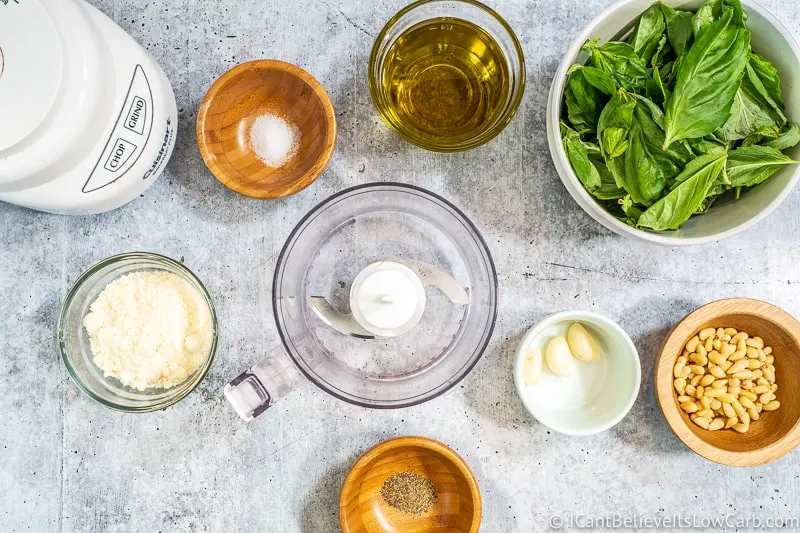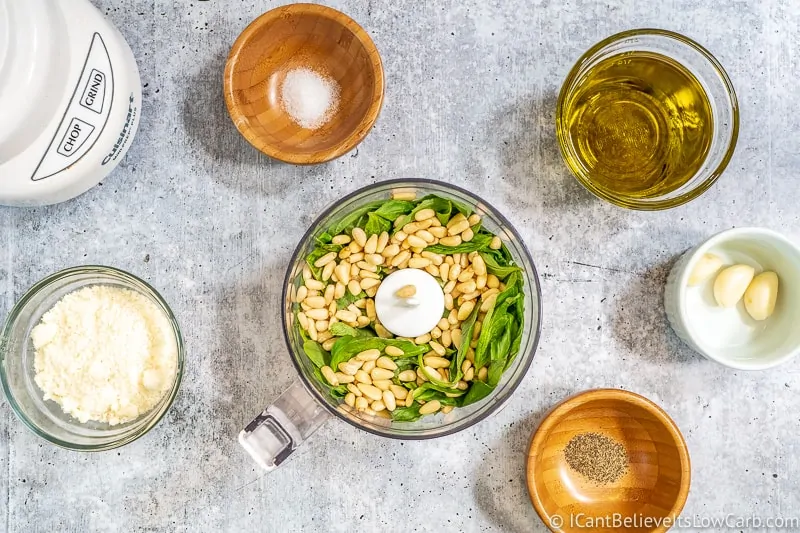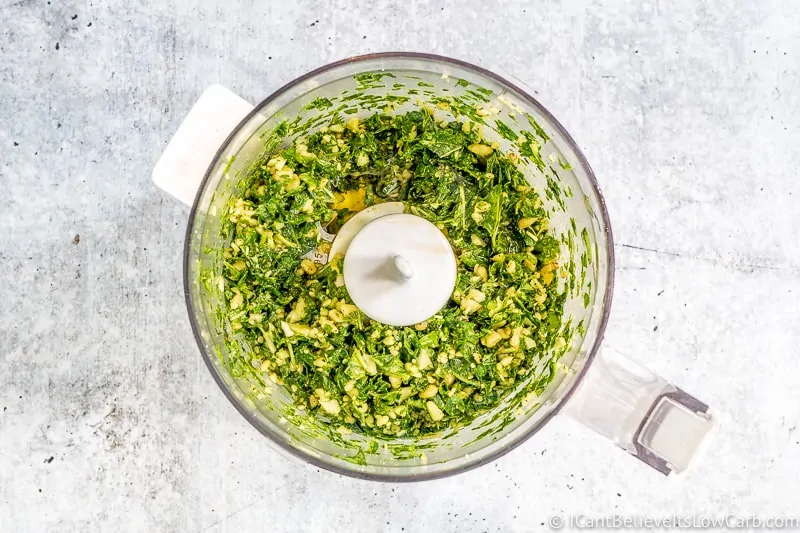In less than 5 minutes you will have the best fresh Basil Pesto Sauce you could ask for. Throw all the ingredients in a food processor or blender and you will have a delicious sauce that goes on pretty much everything. I guarantee that it will be your new favorite go-to recipe.

One of my favorite things about summertime is walking out to my patio and having all my fresh herbs growing. Having fresh herbs makes almost every meal more flavorful and lovely. I always have 2 pots of fresh basil, and I can’t even tell you how much that’s already come in handy this summer.
I’ve made fresh pesto sauce at least 3-4 times already in the last 2 months. It’s so good that you can pretty much eat it with a spoon. But if you aren’t like me, then add it to your zucchini noodles, grilled chicken or steak, any kind of sandwich, salads…it literally can go on anything.
I highly suggest adding this pesto recipe to your list of favorites, it’s a must-have in my book!
What is Pesto?

Pesto or pesto alla Genovese is a vibrant green sauce made out of fresh basil leaves, pine nuts, garlic cloves, parmesan cheese, and olive oil.
Pesto originated in Genoa, Italy, where the term pesto is derived from an Italian verb ”pestare” which means “to crush, beat, or grind”. Traditional pesto made in Genoa is made using a Mortar and Pestle, hence the name.
Here in the U.S. pesto is more commonly made using a food processor, and is a versatile sauce that we use on a countless number of things including pasta, sandwiches, salads, steak, chicken, shrimp, etc. Honestly, the list goes on and on.
One of the nice things about pesto is that you can stray a little bit away from the traditional ingredients, by using different kinds of nuts, leaving out the cheese to make it dairy-free, or using kale instead of basil. Whichever way you make it, I guarantee that you will love this basil pesto recipe!
What Does Pesto Sauce Taste Like?
I don’t really know how to explain what basil pesto tastes like exactly. But all I can say is that you mainly taste the basil and garlic goodness…oh and don’t forget the parmesan cheese flavor thrown in there. I personally don’t taste the pine nuts, but some people say that they faintly can taste it.
Is Pesto Healthy?
In moderation pesto is healthy. While it can be high in fat and calories due to the olive oil and cheese, it does contain other nourishing ingredients.
Basil contains antioxidants and numerous vitamins. Pine nuts are high in calories but also rich in vitamin E, omega 6, and several other vitamins.
What Ingredients is Pesto Sauce Made of?

- Fresh Basil Leaves – Fresh basil is key to this recipe. I grow my own basil and use that all summer long. But the rest of the year I just buy fresh basil at the grocery store. When measuring fresh basil leaves, loosely pack down the leaves into your measuring cup. Small thin stems are ok to add, but try to get rid of the thicker stems.
- Pine Nuts – Pine nuts are found in traditional pesto, but can be swapped out with walnuts, almonds, pepitas, or pecans. Pine nuts are a more expensive nut, but they are tender and high in fat making resulting in a smooth and silky pesto sauce.
- Olive Oil – I recommend using a higher quality extra virgin olive oil. Don’t use a light olive oil.
- Garlic – Fresh whole garlic cloves are what you want. Don’t waste time chopping them, the food processor will do that for you. If your cloves are big then 2 should be enough. but you can add more if you are a real garlic lover.
- Parmesan Cheese – You will find grated or shredded Parmigiano-Reggiano cheese in traditional pesto. But if you have a dairy allergy or you are a vegan then simply leave this ingredient out. My mom doesn’t eat dairy so I always make her batch without the cheese.
- Salt and Pepper – I only add in about ½ tsp of each for added flavor. But feel free to add more or less based on your tastebuds. Salt may help to reduce any bitterness the basil may have.
What Makes a Good Pesto?

A good pesto recipe is all about making sure you have good high-quality ingredients:
Cheese – If you want an authentic Italian pesto sauce make sure you use the real imported Parmigiano-Reggiano from Italy. Don’t buy the cheap domestic parmesan cheese. Trust me, there’s a difference.
Olive Oil – Use a good high-quality extra virgin olive oil…(the green one). You don’t want to use light olive oil, that you would use more for frying with.
Mortar and Pestle – Authentic Italian grandmothers would chop their ingredients by hand then add it to a mortar and pestle and grind it together. It really enhances all the flavors and makes them pop.
Should You Toast Pine Nuts Before Making Pesto?
I don’t toast my pine nuts because I’m lazy and I just always forget to. I’m being completely honest with you guys.
That being said, toasting the pine nuts before adding them to the food processor or blender is actually a good idea. When you toast the pine nuts it deepens their nutty flavor and will improve your pesto.
BUT be very careful, because they will change from being golden to burnt in 2 seconds! So watch them carefully. You can toast them on the stove or in the oven.
What Can You Use in Pesto Instead of Pine Nuts?
One of the many good things about basil pesto sauce is you don’t technically have to use pine nuts. They are pretty expensive and tend to not be a staple in everyone’s pantry. But you can replace pine nuts with the following options:
- Walnuts
- Blanched Almonds
- Pecans
- Pepitas (pumpkin seeds)
Any of these options will work just fine. I would say that walnuts tend to be everyone’s go-to replacement nut because you can buy them in bulk at a good price and most people have them stocked in their pantry.
Do You Use Basil Stems in Pesto?

Discard the larger thick stems before adding them to the food processor. They tend to be tough and leave you with a bitter flavor. I will just pinch them right off with my fingers, it only takes a minute to get them all off.
What Can Be Substituted for Basil?
Ok so let’s say you don’t have any basil in your house, or you just don’t like the taste of basil. What can you do? You can replace the basil with:
- Fresh Kale – Don’t knock it until you’ve tried it. It’s really good! Just make sure you remove the stems first, otherwise, will add bitterness to your homemade pesto sauce.
- Spinach – I like to buy the bags of fresh spinach, it’s already prewashed and ready to go.
- Arugula or Baby Arugula
Can You Add Water to Pesto?
I wouldn’t just add plain water to your pesto recipe to thin it out, it will ruin the texture of your pesto sauce.
But a little tip you could do is, if you are making pasta and adding pesto to it, you can add a little bit of the leftover pasta water to the pasta to thin it out. When I say a little I mean a little. Start with a tablespoon at a time.
How to Make Pesto Sauce from Scratch

Follow these simple instructions for making your own homemade basil pesto recipe:
1. Pulse the dry ingredients together in a food processor or blender. Basically just the basil, pine nuts, garlic, salt, and pepper. Pulse until everything is finely chopped.
2. Add in half of the olive oil. Turn the food processor off and add in half of the olive oil, then puree until smooth. Scrape down the sides if you need to.
3. Transfer to a bowl and add the following ingredients – Once the pesto is moved into a bowl, add in the parmesan cheese and the remaining olive oil. Stir until well combined.
4. Serve and enjoy. Now it’s time to serve your pesto sauce or store in an airtight container or jar and place in the fridge.
Can You Use a Blender Instead of a Food Processor for Pesto?
If you don’t own a food processor that’s ok, you can still make a homemade pesto sauce. If you have a blender then just add all your ingredients to the blend until smooth. I own a Vitamix and that works great, but any blender will work too.
Now if you don’t own a food processor or a blender it’s ok. Chop all the ingredients by hand using a large chef’s knife. Your Italian grandma will probably tell you that this is the best way to do it anyways.
Best Tips for Pesto Sauce

A few tips for making homemade pesto sauce:
- MAKE IT DAIRY-FREE/VEGAN/PALEO/WHOLE30: Discard the parmesan cheese entirely, or replace it with 1 tbsp of nutritional yeast.
- MAKE IT NUT-FREE: Replace the nuts with pepitas or sunflower seeds.
- Choose a high-quality extra virgin olive oil.
- Toast the pine nuts before adding them to the food processor, but be sure to toast them on a low heat and watch them carefully so they don’t burn.
- Step out of the box by using kale, spinach, arugula, walnuts, pecans, pistachios, pepitas, or sunflower seeds.
- If you don’t have a food processor or blender you can chop your ingredients by using a large chef’s knife. That’s how it’s done by your Italian grandmother.
What Causes Bitter Pesto?
Bitterness in your pesto can be from the basil leaves. Basil can grow bitter if the flowers are allowed to mature to seed, or if you overwater the basil it can lead to bitter leaves.
Another reason it may be a little bit bitter can be your olive oil. If that’s the case you can add more nuts or cheese to counteract the bitterness.
Different Variations of Pesto

Oh man, there are so many different variations you can make to this classic homemade pesto sauce. I can’t go through them all, but let me share some ideas with you:
- Swap the basil out for other different greens or herbs and you can get these different kinds of pesto sauces:
- Kale Pesto
- Spinach Pesto
- Arugula Pesto
- Cilantro Pesto
- Use different nuts like:
- Walnuts
- Blanched Almonds
- Pepitas
- Pecans
- Pistachios
- Replace the basil with different herbs:
- Parsley
- Cilantro
- Red Pesto Sauce – Mix sundried tomatoes, roasted red peppers, basil, nuts, olive oil, and cheese (optional).
- Spicy Pesto – Add in some chopped jalapenos or crushed red pepper flakes.
- Creamy Pesto – On the stove combine butter, heavy cream, chopped garlic, and fresh pesto and cook until thickened. Serve over pasta or zucchini noodles.
Diets This Recipe is Good For
- Gluten-Free – I love giving you gluten-free recipes like this basil pesto sauce.
- Vegetarian – This homemade pesto contains garlic, olive oil, basil, nuts, and cheese….completely vegetarian.
- Low Carb – Not only is this homemade pesto gluten-free and vegetarian it’s also low carb and keto-friendly. For 1 tablespoon it has only 0.3 NET CARBS.
- Paleo & Whole30 – Because of the cheese, it’s not Paleo or Whole30 compliant. But leave the cheese out and you now have a Paleo and Whole30 basil pesto sauce.
Is Pesto Vegan?
This recipe isn’t vegan because it does contain cheese, but we can easily make it vegan for you. All you need to do it leave the cheese out and you’ve got yourself a vegan homemade pesto sauce. Or you can add in 1 tbsp of nutritional yeast, it will give you a nice cheese flavor.
How to Use Pesto and What Do You Eat Pesto With?

It might be easier to tell you what pesto doesn’t pair well with…I have a feeling the list would be shorter. But I know, I know that’s not how this works.
So let’s talk about what goes well with pesto sauce:
- Zucchini Noodles – This is a great low carb or keto option. Zucchini noodles are super versatile and can be put with many different sauces and proteins. But one of my favorite ways to eat zucchini noodles is with this fresh pesto sauce served over it.
- Pesto Chicken – Add a spoonful of pesto on some grilled chicken, then add chopped tomatoes and fresh mozzarella. Place in the oven for 5-10 minutes…perfection!
- Shrimp Pesto with Spaghetti Squash – This is top on my list!! It’s sooo good!
- Pesto Gnocchi – If you love gnocchi try it with some fresh pesto. Take it to another level.
- Pizza – Might sound odd, but trust me it’s delicious.
- Pesto Potato Salad – This can be served as a hot or cold potato salad.
- Pesto Pasta – Before I started eating low carb, adding pesto to my tortellini was my go-to comfort food.
- Pesto Chicken Sandwich – Toast your low carb bread or regular bread and smother it in fresh pesto. Add grilled chicken breast, roasted red peppers, and onions.
- Salmon – Pesto, and salmon go great together. Whether cooked in the oven or on the grill, pesto tastes delicious with it.
How to Store This Recipe
To store your homemade pesto properly, transfer it to an airtight container or preferably a glass jar and place it in the refrigerator. In order to prevent the pesto from turning brown, drizzle a little bit of olive oil on top of it then cover it with a lid. By doing that it will help to keep the herbs fresher or a longer period of time.
Your homemade pesto should last for a least a week or two in the fridge, but honestly, mine never lasts that long. It’s usually eaten after a day or two.
Can You Freeze Pesto?
Yes, you totally can freeze this basil pesto! In fact, it’s a brilliant idea. One of the best ways to freeze your pesto is to put it in ice cube trays and that it’s divided into small portions.
Once they are frozen, pop them into a Ziploc bag and store in the freezer. This way you can pull out as many as you need, whenever you need.

Other Delicious Sauce Recipes:
If you’re in the mood for some other Low Carb Sauces then try our:
- Sugar-Free Keto BBQ Sauce
- Tzatziki Sauce
- Perfect Keto Gravy
- Keto Cheese Sauce
- Sugar-Free Cranberry Sauce
All of them are Keto-friendly and low carb, and will have your friends raving!
Print
Best Fresh Basil Pesto Recipe
- Total Time: 5 minutes
- Yield: 18 Tablespoons (1 Tbsp Per Serving) 1x
Description
In less than 5 minutes you will have the best fresh Basil Pesto Sauce you could ask for. Throw all the ingredients in a food processor or blender and you will have a delicious sauce that goes on pretty much everything. I guarantee that it will be your new favorite go-to recipe.
Ingredients
- 2 cups fresh basil leaves
- ¼ cup pine nuts
- 2 whole garlic cloves
- ½ cup extra virgin olive oil
- ½ tsp salt
- ½ tsp pepper
- ½ cup grated parmesan cheese
Instructions
- Add the basil, pine nuts, and garlic cloves to a food processor or blender. Pulse the dry ingredients together until everything is finely chopped.
- Pour in half of the olive oil and puree until smooth. Scrape down the sides if you need to.
- Transfer to a bowl and add the remaining olive oil and the parmesan cheese. Stir until well combined.
- Serve immediately or store in an airtight container and keep refrigerated.
Notes
0.3 NET CARBS PER TABLESPOON
MAKE IT DAIRY-FREE/VEGAN/PALEO/WHOLE30: Discard the parmesan cheese entirely, or replace it with 1 tbsp of nutritional yeast.
MAKE IT NUT-FREE: Replace the nuts with pepitas or sunflower seeds.
Choose a high-quality extra virgin olive oil.
Toast the pine nuts before adding them to the food processor, but be sure to toast them on a low heat and watch them carefully so they don’t burn.
If you don’t have a food processor or blender you can chop your ingredients by using a large chef’s knife. That’s how it’s done by your Italian grandmother.
Step out of the box by using kale, spinach, arugula, walnuts, pecans, pistachios, pepitas, or sunflower seeds.
For a Red Pesto combine sundried tomatoes, roasted red peppers, basil, nuts, oil, and cheese (optional).
- Prep Time: 5 minutes
- Category: sauce/Dip
- Cuisine: Italian











